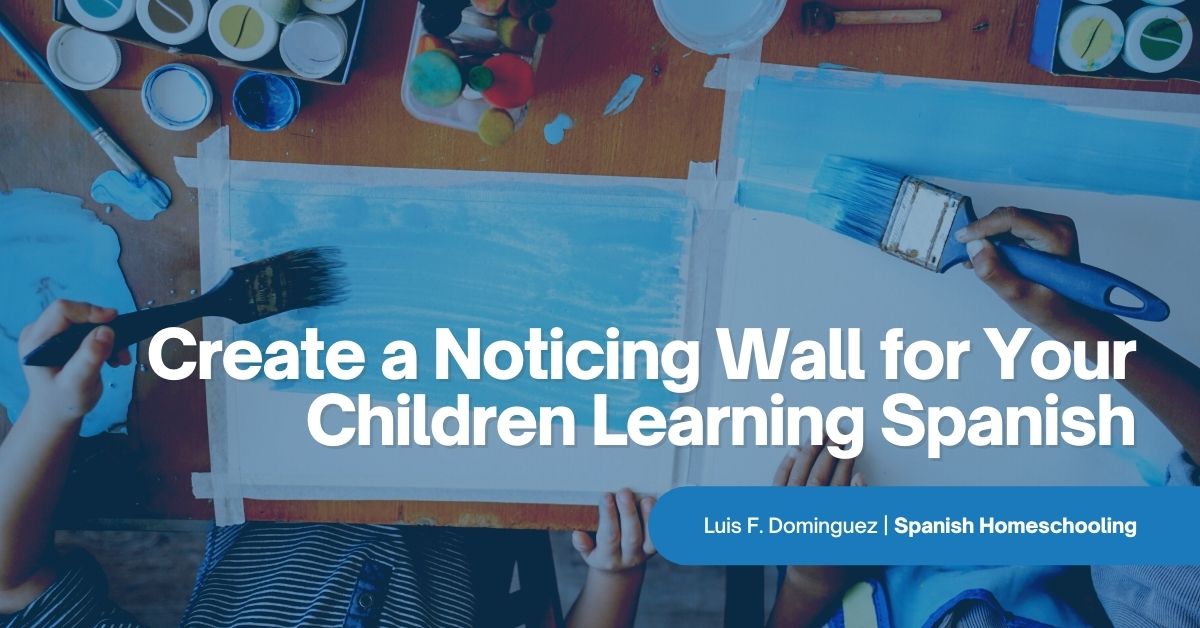
Create a Noticing Wall for Your Children Learning Spanish
If your children are learning Spanish at home and you want to help them to improve their language learning process, you should be interested in learning what a noticing wall is and how to create one.
In this post, I’m exploring with you the different organization tools available for homeschooling language learning children, such as a weekly and a noticing wall. I’m teaching you how to create and use both of them and also giving you some tips on how to engage your kids with these tools.
Introducing Organization Tools for Your Homeschooling Children
Homeschooling is a fascinating universe with plenty of moving parts that offers a lot of benefits for your children or students. Many families had engaged in this adventure long before the pandemic, but when Covid-19 hit the world millions of students, parents, and teachers around the globe discovered firsthand the many benefits and challenges that homeschooling brings to the table.
However, not all homeschooling experiences are the same. Since the pandemic started I’ve taught in two schools from two different countries and the experiences couldn’t have been more different.
This means that you can always improve the way you deal with the homeschooling experience. There are different tools and strategies that can help you to do exactly that. From designing the perfect study environment at home and learning how to keep track and measure your kids’ progress, to using a weekly or creating a noticing wall to help your children to learn Spanish.
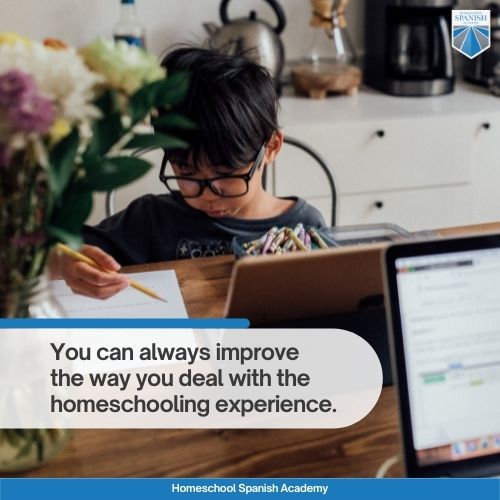
Using a Weekly
I guess every teacher doing homeschool uses a version of this tool even if they don’t call it a “weekly.” The weekly is a simple organizational tool that basically allows everyone in the class to learn about the goals and agenda for the week, get important notices sent by the teacher, and add useful links and even homework in some cases.
In my case, that weekly was the ‘stream’ on Google Classroom on my first school, and the ‘general’ tab on Microsoft Teams on the second one. It’s the place where I, as a teacher, can put everything I think will help my students to learn at home, and it’s also an excellent communication channel with my students.
If you’re at home with your child, you may not need to use a software tool. But the need for the weekly is still there. Find a whiteboard or a cork bulletin board, where you can add the goals for the week, a schedule, some worksheets, or useful materials that give your kid a sense of how their learning experience is going to be week after week.
How to Use a Weekly to Increase Student Engagement
As a teacher, a weekly is a great tool to teach your kids and increase student engagement. Kids love to use technology and they’re naturals at it. I was surprised by how enthusiastically they took on the remote learning tools that we had to use.
Once I posted a notice or the goals for next week, they would start giving me feedback about them or chatting between themselves about the subjects. If you tell them that there will be a group project, they would start creating their teams and planning how and when they would work.
Sometimes I would add an image or a link while I was working on my planning, just to not lose it or forget to add it later, and they would start asking questions about it even before I told them what it was for.
Finally, when kids know what’s the schedule and goals for the week (or day), they focus more on achieving them. Goals work as guiding lights and kids use them as motivators too.
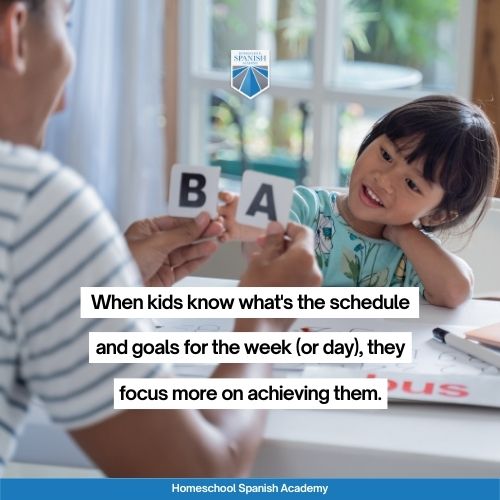
What Is a Noticing Wall?
A noticing wall, on the other hand, is a “zero-pressure space for parents and kids to write notes to each other, ask questions, jot down fun things you learned and make plans,” as defined by Michelle Woo from lifehacker.com.
It’s also an organization tool that helps you to improve your homeschooling experience and, although similar, it doesn’t play the same role as a weekly. Think of a noticing wall as an informal space where you can place literally anything that you may think can help your kids to learn Spanish. That includes drawings, poems, pictures, worksheets, challenges, riddles, anything you can think of.
However, it differentiates from a weekly that whatever you may put in your noticing wall isn’t required learning. Your kids or students will pick up whatever they feel attracted to or challenged about. It’s a smart way to make your kids’ Spanish learning process more interesting and also a way to have fun with them.
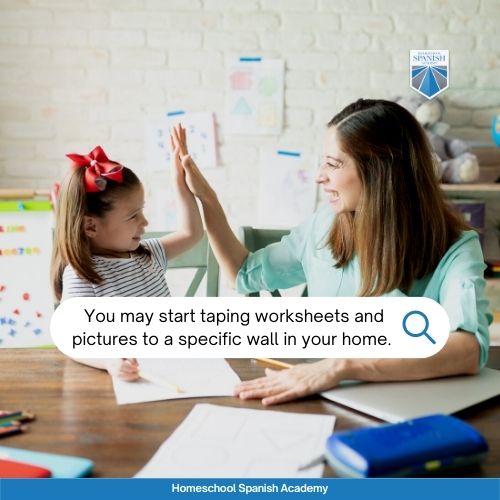
How to Create a Noticing Wall for Your Kid
If you’re at home with your kids, the best idea is to simply grab a cork bulletin board and start adding stuff there until your kids solve one of the riddles or engage in one of the challenges. t
An online noticing wall for teachers and students can also work. In this case, my recommendation would be to just open a new folder where you can add all kinds of materials with your students and share it with them. Once, in a brief moment of inspiration, I created a blog that would serve me as a noticing wall for my students, and their reaction to it was very positive.
Just remember that if you want to create a noticing wall for kids, you need to make it attractive to them. This tool is all about grabbing their attention and challenging them. They need to feel free to ignore it and just engage with it when something catches their attention.
How to Use Noticing Walls to Increase Spanish Learning
Once you have created your noticing wall, it’s time to start using it to increase your kids’ Spanish learning.
Here are some useful ideas:
1. Games
Nothing will make your kids look at the noticing wall you just created for them as the sight of some fun-looking game. Print a bingo, or connect four game in Spanish for them to practice some vocabulary you want them to learn.
If your noticing wall is online you can always add links to quizlet, rockalingua or any other website filled with Spanish games.
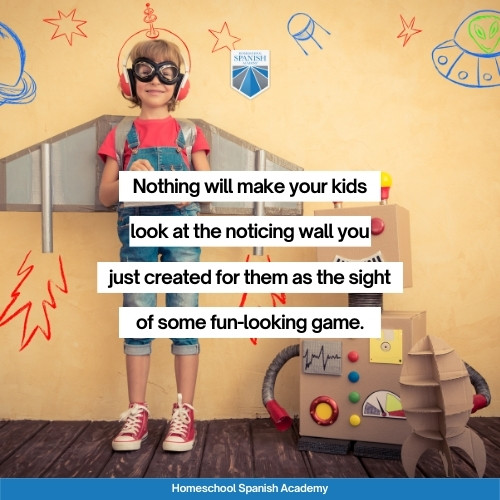
2. Riddles
Kids love riddles and your noticing wall should have lots of them, just make sure that they’re always in Spanish. That way, the first challenge will be to decipher what the riddle says, and then solve it, making it a double challenge!
3. Challenge Your Kids
Both riddles and games are challenges themselves, and that’s because kids love to be challenged. They love to compete and feel the joy of winning and achievement.
Once you’ve tried with fun stuff like games and riddles, and have made sure that your kids are actually noticing the noticing wall, start creating more elaborate challenges. You can add to your noticing wall a list of difficult verb conjugation sets and challenge your kids to master them in a week. However, with these types of challenges, you need to be ready to offer some kind of reward to make the challenge interesting and catch your kids’ attention.
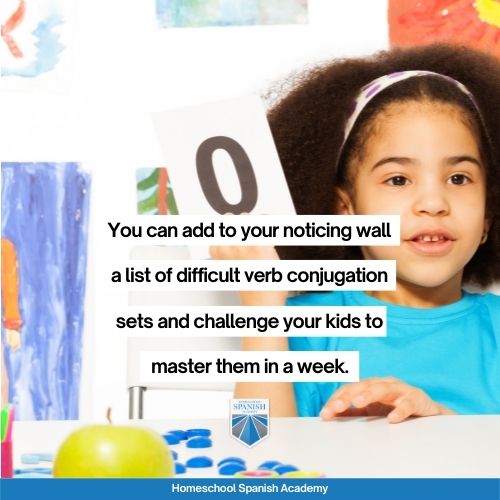
Create a Noticing Wall for Kids and Improve Their Spanish
There are many ways to improve your kids’ Spanish and creating a noticing wall is one of the most engaging and fun ones you can think of. It takes the formality out of the learning process and makes it an interesting way to explore new paths to learning Spanish.
Remember that children of a young age are capable of understanding naturally complex grammar rules. When it comes to languages, the earlier they begin, the easier it’s for them to learn.
Get your student speaking Spanish with a native speaker from Guatemala! Sign up for a free class, 1-on-1 or 2-on-1, we also have group class options that act as support. We offer flexible scheduling and tailored Spanish packages.

Want more free Spanish lessons, fun content, and easy learning strategies for kids? Check these out!
- All You Need to Know About Spanish as a Second Language
- Discover the Joy of Learning Spanish with Summer Fun Activities
- Are Bilingual Children More Likely to Experience a Speech or Language Delay?
- What Is An Umbrella School?
- The Best Homeschool Spanish Curriculum at HSA
- From Burnout to Balance: Creating a Healthy Happy Homeschool Routine
- Language Learning with Netflix: How to Use the Chrome Extension
- Turn Your Life Around: From Passive Bilingualism to Fluency!
- All You Need to Know About Spanish as a Second Language - July 11, 2024
- The Best Homeschool Spanish Curriculum at HSA - June 13, 2024
- 20 Most Common Subjunctive Triggers in Spanish - May 23, 2024




